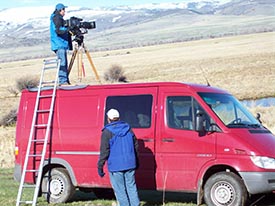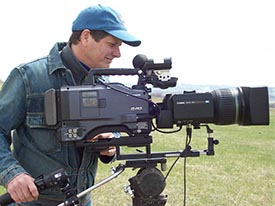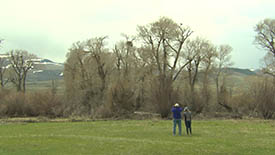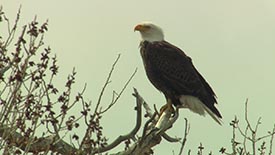If you get this close to heaven bring a long lens.
O’Dell Creek, Ennis Montana
60 miles north of the west gate of Yellowstone, east of Virginia City, in southwestern Montana there’s a very special valley. On the “bench” (which, where I come from, we call a “bluff”) can be found large rings made up of stones mostly the size of flattened bowling balls, some slightly larger. Native Americans, who used them to hold down the edge of their tipis, left these there long ago. From the bench, one looks out across a valley dotted with springs that feed a multitude of brooks and channels that drain into the O’Dell creek, a tributary of the Madison River seen off in the distance. The reason there are so many tipi rings is that the area below supports a multitude of fish, birds and wild animals. This wetland was and still is prime fishing and hunting ground. Way back in the 1950’s some ranchers thought it would be a good idea to ditch this area and drain the water off to make a little extra pasture for their cattle. I don’t need to go into detail here about the long-term affect on the wildlife; you can very well imagine.

Sorensen on top of van. Jeff Laszlo on ground. “I climbed up on the top of my truck, and put the camera with the HJ40 on my lightweight sticks. The camera was buffeted by the wind and I was shivering so much I could hardly keep my eye to the eyepiece. When I switched on the HJ40’s stabilizer the image became rock steady. That shot would otherwise have been impossible to get under these conditions.”
Several years ago my good friend Jeff Laszlo, an accomplished cameraman in his own right, told me that they were restoring the wetlands on his family’s and a neighboring ranch. This sounded like a wonderful story. “Jeff,” I remember saying, “Someone’s got to record this on video before the restoration is completed.”
In the spring of 2007 I found myself, camera in hand, chasing Sand Hill Cranes across a field of pugs and hummocks, deep holes left by cattle in the mud. Distance in this valley is deceptive. What at first appears like a short stroll soon becomes a hike of mile or more. No sooner would I be able to get close enough for a reasonable shot than the birds would take flight increasing the distance once again between them and my lens.
Several times that summer I visited the ranch, meeting and interviewing people connected with the project. I shot everything on my new Panasonic HPX 500 P2HD, a 2/3-inch chip camera. My normal lens for this camera is a Canon HJ17ex7.6B IRSE portable HD ENG/EFP zoom lens. This lens has a 2x extender and is versatile. It gives me a focal length ranging from 7.6mm to 130mm (15.2mm to 260mm with Extender). Under most circumstances this is “all the lens” I really need shooting in a documentary situation. I soon found that shooting on O’Dell Creek was a different situation. The wildlife there is very skittish. The Sand Hill Cranes I was stalking could see us from more than a mile as I approached across the field. If you are close enough to make the birds uncomfortable, they simply fly over to another area. Even with the 2x extender on my 17×7.6 lens I couldn’t get close enough to get shots of those birds. I needed a lens that was compact enough to carry mounted on the camera while hiking over the rough terrain yet with a long enough focal length to capture the wildlife.

Dickson Sorensen has a distinguished career as Director and DP on many high-end commercials. He was second unit DP on “Flashdance,” and is known for his technical and artistic virtuousity.
The following spring (2008) I returned again to record the changes that the restoration was producing on O’Dell Creek. This time I was lucky to have an added tool in my toolbox. I’ve used almost every manufacture’s lenses over the years and have always found that Canon’s lenses are of consistently high quality. It came as no surprise when I had an opportunity to test-drive the Canon HJ40x10B telephoto EFP lens that it would meet my expectation of Canon’s excellent reputation. What surprised me though is how this lens helped me get shots otherwise difficult, if not otherwise impossible, to obtain. The lens arrived with Canon’s mounting plate and remote focus and zoom controls. The support bracket goes on without any tools; thus it is very easy to change out in the field and has a sliding leveler to quickly balance.
The lens weighs less than 12 pounds so the entire package, camera, battery (which also provides power to the lens) and mounting bracket ends up at roughly 25 pounds. That kind of weight I can deal with on my shoulder for a hike of a mile. Canon’s accessories supplied with the lens were very well thought out. When Canon’s ZSD300D zoom control is used with the lens you get full functionality on your pan handle. With “aftermarket” zoom controls I’ve always been frustrated by not being able to snap tight for focus, return to mark, change zoom speeds or access other electronic functions without reaching my left hand over to the right side of the lens. If you get a chance to use this lens, request that Canon’s zoom control is supplied with it. When shooting wildlife, my left hand is always on the barrel of the lens ready to shift the focus if my subject moves unexpectedly. I didn’t use the supplied studio focus control but the lens has a servo for focus if that’s your style. I found the mechanical layout very pleasing. The function buttons were laid out similarly to my Canon 17×7.6, so right out of the box it felt familiar.

Framegrab. Wide end of the lens.
The HJ40x10B has, as the nomenclature states, an incredible 40 times zoom ratio with the built-in extender that doubles it to an impressive 800mm at the long end. Without the extender this lens is tack-sharp. With the extender I was able to enter a world I had only dreamed of with my normal hand-held lens. Suddenly the Sand Hill Cranes I had been chasing relentlessly across the field were right before me. I got a shot of a Sora Rail, a rare wetland bird not seen on O’Dell before the restoration. Bald Eagles nesting while their fuzzy-headed eaglets now and then popped their heads up, two male Cinnamon Teal Ducks fighting savagely over a female, Coots dunking comically while feeding on the bottom—these are only a few of the shots that came instantly into view once the lens was mounted.
The best feature of the lens though is the built in stabilizer. When you’re out in the field, traipsing around with a minimal crew, or even no crew at all, every extra pound you carry is important. Normally when working with a long lens it’s a good idea to have as heavy a tripod and head as possible. If you are in the wind try to get out of it if you can. That is… unless you happen to be carrying Cannon’s HJ40x10B. There is a little switch on the back of the electronic unit that turns on the stabilizer. Once activated, the stabilizer kicks in and magically removes annoying jiggle and shake common to long lens shooting. With this lens I was able to use my lightweight tripod and head with very acceptable results. Elk were spotted over a mile in the distance jumping a ranch fence, a shot I needed for the narrative in the film. I climbed up on the top of my truck, and put the camera with the HJ40 on my lightweight sticks. It was 20 degrees, snowing and the wind had to be blowing 30 to 40 miles an hour. The truck was rocking back and forth in the broadside gusts. The camera was buffeted by the wind and I was shivering so much I could hardly keep my eye to the eyepiece. When I switched on the HJ40’s stabilizer the image became rock steady. That shot would otherwise have been impossible to get under these conditions.

Zoomed in from same position as Wide shot, above. But when the park rangers saw this shot, they said, “you’re not allowed to get that close to these endangered birds.”
They didn’t realize we really were a safe distance away, thanks to the lens.
Canon makes a sister zoom to the HJ40x10: the HJ40x14. This lens starts at 14mm and goes to 1120mm with the 2x extender. The tighter long end would at times be useful, though one of the things I really like about the 40×10 is that I always have wide angle to capture the unending Montana panorama on O’Dell Creek. The work on O’Dell Creek will continue for several more years; there are over one thousand acres of wetland to be restored. In the meantime the increase in fish, waterfowl and wildlife shows a measurable success. It’s important that we protect and preserve these places so that future generations can enjoy them too. In the words of James Audubon, “A true conservationist is a man who knows that the world is not given by his fathers, but borrowed from his children.” It’s given me much pleasure to show people the work that the partners restoring the O’Dell Creek are doing. Canon has provided a wonderful tool for doing that.








